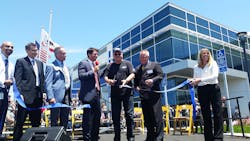Gillig Heads to New Facility
"Quality is a reflection of our people." That was the sentiment you heard reiterated by Gillig President Derek Maunus and other officials at the official ribbon cutting event held at its new headquarters in Livermore, California, on June 1.
Surrounded by Gillig employees, Maunus spoke of why they chose Livermore for the location of the larger facility, about 20 miles from its previous facility in Hayward. "These 900 men and women. This team made the company successful. They put their heart and soul in everything they." He added, "Same team, better tools here."
Livermore Mayor John Marchand pointed out Gillig started in San Francisco in 1890 as a carriage and wagon shop. He said, "Because of Gillig's leadership and commitment to its workforce and to its buses, their quality is a reflection of our people."
The facility consists of three buildings totaling just over 600,000 square feet on what was an empty lot. Built with high earthquake resistance — with a seismic design of hospitals, police stations or fire stations — it includes nine paint booths, 74,000 feet of automated lines, a turnstile for turning and moving a chassis, a leveling station for putting e shell on the chassis and lifts to flip the roof assembly.
Maunus mentioned companies that have opened facilities in other countries, moving for low-cost labor. "We've doubled-down on America," he said, because of the "900 men and women that have worked hard for decades to make the company great."
Livermore Chief Building Official Brent Smith mentioned many of the families have two or three generations working at Gillig and keeping the facility close to the previous one allowed for the employees to stay on board. While Maunus was speaking to the crowd, he recognized several employees, including most-tenured Stanley Alcon with 50 years of service and Javier Hernandez Sr., with 42 years of service and four generations with Gillig: his father had worked there, two of his sons currently work there and a grandson will be working there over the summer.
Vice President for Sales and Marketing Joe Policarpio said about 95 percent of the employees stayed on, moving to the Livermore facility.
While Gillig is expected to generate $1 million in sales tax revenue for Livermore each year, Livermore Vice Mayor Steven Spedowfski said it’s not just about the tax revenue, but great people working here.
Gillig didn't stop production at Hayward during this transition. Chris Turner, VP manufacturing & supply chain, said it took three years of hard work to make a reality, two moving companies and a personal moving plan for every production employee. In the end, they only lost less than two days of production.
And it wasn't without its challenges.
Alameda County Supervisor Scott Haggerty mentioned that at the beginning, there were $7 million in fees alone, just to get going. "Texas wanted to charge $0. That was a deal killer," he said.
He referenced discussions between Maunus and the Bay Area Air Quality Management District. He said Maunus would not take no for an answer. "He went to the air board and said their assumptions were wrong."
After many long meetings, the conclusion was there were some things that were needed, such as in the paint booths, but not everything that was initially asked for. Haggerty said, "It was a civics lesson in a business man standing up for his employees."
The weather was also playing against them. After the ground breaking they dug 6 foot trenches and, Maunus said, the rains came and they never stopped. Despite building during an El Niño and the wettest winter in 122 years, he said, "We're here and couldn't be happier.
"It's a great day for the Bay Area, the state of California, and for America and American manufacturing."
